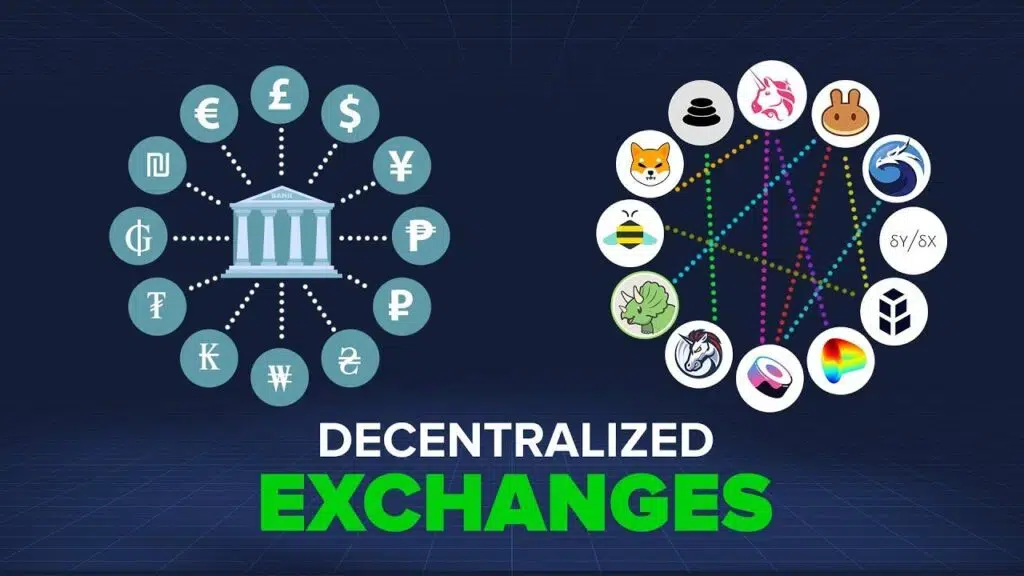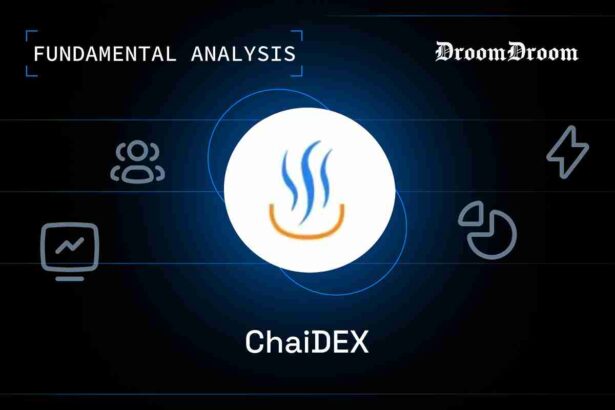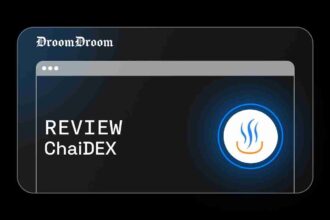ChaiDex $CHAIT fundamental analysis introduces you to a hybrid decentralized exchange, ChaiDEX, and will educate you on everything you must know before investing in $CHAIT, the DEX’s native token. In the fundamental analysis, we will cover what is ChaiDEX, what sets it apart from other exchanges, the tokenomics, and the platform’s security.
- What is ChaiDEX?
- What Differentiates ChaiDEX from other DEXs
- Atomic Swap Technology
- Cross-Chain Interoperability
- Does not Rely on Token Bridges
- High Speed, Low Costs
- Governance and Fee Token ($CHAIT)
- Liquidity Providers for INRC
- Community-Run Governance
- What is $CHAIT?
- How Does ChaiDEX Work?
- ChaiDEX Features Unveiled
- Cross-Chain Asset Purchases and Swaps
- No Wrapped Tokens
- The INRC Stablecoin
- Direct Purchase and Redemption of ChaiDEX Native Stablecoin INRC
- Governance and Fee Token $CHAIT
- Liquidity Providers’ Hub for INRC
- The Team
- ChaiDEX Tokenomics: A Comprehensive Overview
- Token Allocation and Vesting
- Network Improvement (10%)
- Team and Advisors (15%)
- Marketing and Airdrops (5%)
- Investors (10%)
- Public through ICO/IDOs (60%)
- Supply and Distribution
- Security of ChaiDEX
- ChaiDEX Wallet Product Offering
- The Future of DEX Trading
- Evolving User Experience
- Interoperability and Cross-Chain Trading
- Liquidity Solutions
- Regulatory Adaptation
- Innovations in Tokenomics
- ChaiDEX $CHAIT Fundamental Analysis Conclusion
For cryptocurrencies to function 100% according to the vision of Bitcoin founder Satoshi Nakamoto, transparency, security, and decentralization are mandatory. While cryptocurrencies have upheld these attributes, dozens of exchanges have not. There are exchanges with amazing trading features, but where they are not centralized, they lack great user experience. In this ChaiDEX $CHAIT fundamental analysis, we look at how ChaiDEX is revolutionizing a hybrid model for decentralized trading.
The ChaiDex $CHAIT fundamental analysis contains the definition of ChaiDEX, how the DEX works, what makes it different from other existing solutions, the tokenomics, and all its unique features.
ChaiDEX is a hybrid decentralized exchange that eliminates the need for token bridges when interacting with multiple chains. The ChaiDex $CHAIT fundamental analysis dives into the ChaiDEX revolution.
What is ChaiDEX?
ChaiDEX is a multi-chain, non-bridging, and non-custodial p2p exchange that primarily runs on the Ethereum Virtual Machine, but contains several other chains on top of it.
The DEX benefits from a hybrid model that gives it the convenience of a traditional DEX, and the user experience of a fully-fledged CEX. ChaiDEX resulted from the need to enable the transfer of value across chains without bridging.
The result was a decentralized exchange where layer 1 and layer 2 blockchain platforms can interact without relying on token bridges. For this reason, ChaiDEX has won the affection of traders who prefer a secure, private, transparent, and multichain trading platform.
Several challenges and limitations plague the CEX and DEX industry. First of all, DEXes rely fully on protocols that support the transfer of related blockchain assets. For example, Uniswap built on Ethereum only facilitates ERC20 trades. Additionally, the DEX must also have high liquidity for the trade to be successful.
On a CEX, the tokens are not safe but provide great ease of trading. As such, CEX trading is highly efficient and smooth but the funds remain in the hands of the platforms. The role of a hybrid exchange like ChaiDEX is to combine the best of both worlds. Security, convenience, and decentralization. The evaluation below dives into the first Hybrid DEX in this ChaiDex $CHAIT fundamental analysis. Below, what makes ChaiDEX different?
What Differentiates ChaiDEX from other DEXs
Atomic Swap Technology
Atomic Swap technology on ChaiDEX aims for parties to trade tokenized blockchain assets on different networks without a centralized middle party. This method ensures that DEFI users maintain complete decentralization in Web3. For ChaiDEX, atomic swap technology ensures trades occur either entirely or not at all, mitigating risks associated with regular types of trading. This commitment to security and decentralization sets ChaiDEX apart as a trustworthy platform for users.
Solana blockchain as the foundation for ChaiDEX plays a crucial role in setting the DEX apart from other platforms. Operating on Solana ensures low gas fees, making transactions more cost-effective for users. Solana’s robustness also aligns with ChaiDEX’s goal of enhancing accessibility to decentralized trading.
Cross-Chain Interoperability
ChaiDEX believes the entire web3 ecosystem must be interoperable. As such, the emphasis on cross-chain interoperability is reflected throughout the ChaiDEX ecosystem. Unlike many DEXs that limit users to specific blockchain ecosystems, ChaiDEX enables seamless asset purchases and swaps across different chains. This flexibility empowers users to build diverse portfolios effortlessly.
Does not Rely on Token Bridges
ChaiDEX wants to eliminate the reliance on token bridges when facilitating token swaps. As such, DeFi users can swap assets between chains without the complexity of wrapped tokens. Hence, receiving the tokens in their native form. This simplifies the trading process and reduces friction for users.
After reading the extensive ChaiDEX $CHAIT fundamental analysis, consider how token bridges and wrapped tokens work, in our explainer guide for Wrapped Tokens.
High Speed, Low Costs
The peer-to-peer nature of ChaiDEX, where assets are exchanged against INRC on the Solana Chain, leads to low gas costs and high transaction speeds. This efficiency addresses one of the significant pain points in decentralized trading, providing a smoother and faster experience for users.
Direct Purchase and Redemption of ChaiDEX Native Stablecoin (INRC)
ChaiDEX distinguishes itself as the primary distributor and minting platform for its native stablecoin, INRC. This direct link between ChaiDEX and INRC facilitates easy purchase and redemption, creating a bridge between traditional stablecoins and DEX trading.
Governance and Fee Token ($CHAIT)
The introduction of the CHAIT token adds another layer of uniqueness. CHAIT serves as the fee token for the platform, with users utilizing it to pay a modest 0.1% of the trade amount. Looking ahead, $CHAIT will play a pivotal role in a decentralized autonomous organization (DAO), giving users decision-making power in the platform’s governance.
Liquidity Providers for INRC
ChaiDEX positions itself as the primary platform for liquidity providers backing INRC. This strategic move fosters a robust ecosystem around the native stablecoin, contributing to ChaiDEX’s overall liquidity and sustainability.
Community-Run Governance
Thanks to the community-run model that ChaiDEX aims to foster, the DEX is looking towards establishing the ChaiDAO. The decentralized autonomous organization will empower participants through the network’s native token $CHAIT. Thereby ensuring a community-driven and decentralized governance model.

What is $CHAIT?
$CHAIT is the native crypto of the ChaiDEX trading ecosystem which is used for gas fees, trading, governance, or incentivising security. The token runs on the SPL protocol, a native chain built on the Solana blockchain. Thanks to the blockchain, $CHAIT features low gas fees and high-speed transactions.
CHAIT will be burned in stages until the total lifetime supply reaches 5 billion. This will be achieved through a buy-back and burn mechanism. Initially, for the first year, 50% of the fees accumulated by the DEX each month will be bought back and burned. After one year, there will be a staggered burning.
$CHAIT will have a liquidity pool comprising USDT, USDC, and BUSD. However, the network will automatically convert the entire liquidity pool into USDC as a mechanism for maintaining the stability of the INRC stable token. Transacting on ChaiDEX will attract a gas fee of 0.1%. The network will always split the gas fees into two, with 80% going to the APY pool and the remaining 20% going to the liquidity maintenance pool.
How Does ChaiDEX Work?
ChaiDEX is not an exchange like any other; Instead, ChaiDEX is a revolutionary platform that combines decentralization, transparency, and seamless trading using the power of blockchain technology.
The decentralized exchange has a robust infrastructure built on the Solana blockchain, a choice made for its efficiency and cost-effectiveness. Leveraging the Solana Chain has enabled ChaiDEX to minimize gas fees, making transactions more accessible and affordable for users.
One of the standout features of ChaiDEX is its utilization of Atomic Swaps. This secure, fast, and reliable approach to transferring transactions ensures users trade with confidence. The Atomic Swap concept guarantees that transactions occur simultaneously or not at all. Thereby eliminating the risks associated with most regular crypto exchanges. The next section of the ChaiDEX $CHAIT fundamental analysis dives into the features of ChaiDEX.
ChaiDEX Features Unveiled
Cross-Chain Asset Purchases and Swaps
Interoperability is the flagship product feature of the ChaiDEX exchange. As such, the network facilitates seamless buying and selling of assets across different blockchains. Thereby ensuring users can build diverse portfolios without the hassle of navigating dozens of platforms.
No Wrapped Tokens
ChaiDEX does not want traders to rely on wrapped tokens, hence the exchange enables swaps between chains where users receive tokens in their native form. Thereby eliminating the need for bridges to convert tokens.
The INRC Stablecoin
ChaiDEX operates as a peer-to-peer (P2P) decentralized exchange where assets are exchanged against the network’s native stablecoin, INRC, initially existing on the Solana Chain. This unique approach ensures high transaction speeds and low gas fees. Thereby bringing accessibility and affordability to crypto trading.
Direct Purchase and Redemption of ChaiDEX Native Stablecoin INRC
ChaiDEX has taken a pioneering role as the primary distributor and minting platform for INRC. The revolutionary stablecoin will launch on several leading exchanges. Users who want to directly purchase and redeem INRC can do so by utilizing the exchange’s bridge between traditional stablecoins and the decentralized world.
Governance and Fee Token $CHAIT
The $CHAIT token plays a crucial role in ChaiDEX’s ecosystem, serving as the currency for platform fees (0.1% of the trade amount). Looking ahead, ChaiDEX envisions a decentralized autonomous organization (DAO) where $CHAIT holders will have decision-making power, ensuring the platform’s continued adherence to decentralization ethos.
Liquidity Providers’ Hub for INRC
ChaiDEX’s vision extends beyond its current features. The roadmap includes the establishment of ChaiDAO, where $CHAIT will empower participants with decision-making capabilities, fostering a truly decentralized governance model.
The Team
ChaiDEX $CHAIT fundamental analysis evaluates the team behind the hybrid decentralized exchange, partners, and advisors.
Nitesh Mishra, Pramodaa Kalkoti, Jaydip Rathod, and a team of experienced specialists are leading the future of decentralized trading.
Nitesh Mishra, a co-founder and the chief technology officer of ChaiDEX has experience spanning across business, technology, the blockchain, and research.
Jaydip Rathod, the founder of ChaiDEX has a wealth of experience across multiple industries including Real Estate, Energy, Construction, IT, Financial Technology, and the Blockchain.
The Chief Product Officer, Pramodaa Kalkoti packages 8 years of experience in machine learning, artificial intelligence, and data, 3.5 years in the blockchain navigating the sophistication of distributed ledger technologies, decentralized applications, and smart contracts.

ChaiDEX Medium Blog
The innovator appeared on the Forbes 30 Under 30 list at 27 for executing authentic product ideas and curating world-changing technology solutions.
ChaiDEX Tokenomics: A Comprehensive Overview
ChaiDEX, as a decentralized exchange (DEX), has carefully designed its tokenomics to ensure a balanced and sustainable ecosystem. The distribution of tokens plays a pivotal role in shaping the dynamics of the ChaiDEX community.
Let’s delve into the key aspects of ChaiDEX’s token economics below on the ChaiDex $CHAIT fundamental analysis.
Token Allocation and Vesting
Network Improvement (10%)
ChaiDEX has allocated 5% of the token supply towards network improvement. This ensures ongoing enhancements and upgrades to the ChaiDEX infrastructure, contributing to the platform’s
long-term viability.
Team and Advisors (15%)
Recognizing the importance of a dedicated team, 4% of the tokens are allocated to the team and advisors. This incentivizes their commitment to the project and aligns their interests with the success of ChaiDEX.
Marketing and Airdrops (5%)
Building awareness and community engagement is crucial for any project’s success. ChaiDEX allocates 10% of tokens to marketing and airdrops, fostering a vibrant and active user base.
Investors (10%)
Investors play a significant role in the growth and development of ChaiDEX. Allocating 21% of tokens to investors reflects the platform’s commitment to rewarding those who believe in its potential.
Public through ICO/IDOs (60%)
The lion’s share, 60% of tokens, is reserved for the public through Initial Coin Offerings (ICOs) and Initial DEX Offerings (IDOs). This democratized approach allows widespread participation, ensuring a diverse and engaged community.
Decentralization is a core principle for ChaiDEX, and governance is key to achieving this. Chai-T tokens grant voting power, aligning the interests of governance token holders with DEX stakeholders. The governance mechanism, conducted through voting, is set to be launched on the platform, allowing the community to actively participate in decision-making.
Supply and Distribution
Chai-T’s tokenomics include a careful balance between inflation and burning mechanisms. The initial inflation starts at 1 billion Chai-T per year. However, a 10% burning mechanism is introduced, adjusting the inflation to 10% annually through gradual steps starting one year after the launch. This burning mechanism contributes to a controlled and sustainable token supply.
Distribution Breakdown
- Basic Supply: Total Supply – 10 Billion Chai-T
- Total Lifetime Supply: 5 Billion Chai-T
Investor and Team Vesting
For investors and the team, there is a 6 month vesting period with an unlocking period which continues until 36 months, releasing tokens equally each months. This structure ensures long-term commitment and alignment of interests, promoting stability and confidence in ChaiDEX.
ChaiDEX’s tokenomics reflects a thoughtful blend of community inclusivity, sustainability, and decentralized governance. As ChaiDEX celebrates its first year, these tokenomics pave the way for continued growth and success in the evolving landscape of decentralized finance.
Security of ChaiDEX
Smart Contract & Security
ChaiDEX operates on a unique system where participants can seamlessly trade various tokens, including native coins and INRC while ensuring the utmost security. The process involves a series of steps to safeguard the interests of both buyers and sellers.
ChaiDEX Transaction Workflow
Seller’s Deposit
A seller initiates the process by depositing a sum of token-X in chain-X through the ERC20 contract. Simultaneously, they specify the equivalent INRC they anticipate receiving per token.
INRC Quota for Buyers
Details of the maximum INRC a buyer can deposit are then mirrored onto the INRC chain, providing a designated space for buyers to deposit their INRC.
Secure Transaction Execution
The deposited INRC is securely transferred to the seller, with any associated information update charges deducted in the cross-chain process.
Buyer’s Transaction
When a buyer deposits to the INRC contract with a trade, the corresponding amount of token-X they should receive is promptly updated on ChainX. It’s important to note that trades are time-limited, prompting buyers to withdraw their assets from chain-X before the trade concludes. In the event of non-completion, the system refunds token X to the buyer.
Reciprocal Process
The same process is mirrored for sellers looking to exchange INRC for TokenX in chain-X. The details are updated in ChainX, allowing buyers to deposit TokenX for a swap and subsequently withdraw the equivalent INRC.
Smart Contracts and Functions
ChaiDEX relies on specialized smart contracts to manage the various aspects of trading, ensuring a secure and streamlined experience for users. These include:
ERC20 P2P Contract
Records and accepts all trades involving whitelisted tokens.
INRC P2P Contract
Handles and records trades involving INRC as the sole asset.
Native Coin Contract
The Native Coin Contract manages and records trades involving native coins as the sole assets.
By employing these smart contracts and their associated functions, ChaiDEX creates a secure and efficient environment for users to engage in peer-to-peer trading on recognized chains.
ChaiDEX’s security framework revolves around well-organized smart contracts, facilitating seamless transactions while prioritizing the safety and integrity of user assets. The next section of the ChaiDEX $CHAIT fundamental analysis evaluates the ChaiDEX official crypto wallet.
ChaiDEX Wallet Product Offering
Chai Wallet not only embraces the concept of a multi-chain wallet but also champions non-custodial principles, setting new benchmarks for user-centric security. Continue reading the ChaiDEX $CHAIT fundamental analysis to delve deeper:
The Chai Wallet represents a shift in decentralized wallets, boasting non-custodial features and a multi-chain framework. This approach aims to fortify security, and reliability, and, crucially, eliminate vulnerabilities that could lead to breaches or hacks on the ChaiDEX platform.
Key Features of Chai Wallet
Multi-Chain Functionality
The Chai Wallet allows users to manage accounts and their keys across different chains, including Ethereum (the most trusted), Binance Smart Chain (popular among retail users), Polygon (renowned for layer 2 solutions), and Solana Chain (a developer-friendly and secure blockchain). This diverse array of supported chains ensures flexibility and broadens user accessibility.
Isolation from Site Context
An integral aspect of Chai Wallet’s security architecture is its ability to isolate user accounts and keys from the site context. This strategy enhances security by preventing potential vulnerabilities that could arise from storing keys on a single central server or in local storage. The impending addition of hardware wallets in the next update will further bolster the wallet’s security features.
Non-Custodial Nature
Chai Wallet follows the non-custodial model, offering users complete control over their private keys and, consequently, their funds. By removing the involvement of third parties in fund management, ChaiDEX empowers users with an added layer of security, giving them the autonomy they deserve over their crypto assets.
Future-Ready Integration
Under the Chai Wallet umbrella, users can seamlessly generate key pairs. The wallet’s integration with various chains, such as Ethereum, Binance, Polygon, and Tron. Additionally, the DEX delivers on its promise of future compatibility with all EVM-enabled chains, eliminating the need for bridging solutions.
This approach ensures that ChaiDEX users remain at the forefront of technology in the rapidly evolving blockchain space. The next section of the ChaiDEX $CHAIT fundamental analysis evaluates the future of DEXs and decentralized trading.
The Future of DEX Trading
The essence of DEX trading lies in decentralization, a concept that transcends beyond the centralized model of traditional exchanges. It symbolizes a shift in power dynamics, where users reclaim control over their assets, keys, and ultimately, their cryptocurrencies. With centralized exchanges susceptible to hacks and single points of failure, the decentralized approach upholds not only control but also security.
Evolving User Experience
As DEX platforms continue to evolve, so does the user experience. The future promises interfaces that rival the simplicity and intuitiveness of centralized counterparts, erasing the perception that decentralized equates to complex. Enhanced user interfaces, seamless onboarding processes, and a focus on user-centric design will be pivotal in attracting a broader audience to DEX trading.
Interoperability and Cross-Chain Trading
The future of DEX trading is inherently interconnected. Cross-chain compatibility and interoperability are becoming central themes, enabling users to seamlessly trade assets across different blockchain networks. This evolution marks a departure from the siloed ecosystems of the past, fostering a more interconnected and collaborative blockchain landscape.
Liquidity Solutions
Liquidity has long been a challenge for DEX platforms. However, innovative solutions are on the horizon. Automated Market Makers (AMMs), liquidity pools, and decentralized finance (DeFi) protocols are revolutionizing how liquidity is sourced and utilized. These advancements promise to make DEX trading a viable alternative and preferred choice for traders seeking robust liquidity.
Regulatory Adaptation
As the cryptocurrency space matures, regulatory scrutiny becomes inevitable. The future of DEX trading lies in proactive adaptation to regulatory frameworks. Platforms prioritizing compliance, transparency, and user protection will likely emerge as leaders in the decentralized exchange arena. Striking a delicate balance between decentralization and regulatory compliance will be key to fostering widespread acceptance.
Innovations in Tokenomics
The future DEX landscape will witness continuous innovation in tokenomics. Token-based incentives, governance models, and novel mechanisms to reward liquidity providers are poised to redefine how users engage with decentralized exchanges. These tokenomics innovations not only drive community participation but also contribute to the sustainable growth of DEX platforms.
The future of DEX trading is a canvas waiting to be painted with innovation, resilience, and user-centric principles. As the ecosystem continues to mature, DEX platforms will play a pivotal role in shaping the narrative of decentralized finance. The journey ahead is thrilling, promising, and ultimately transformative for both the crypto community and the broader financial landscape. The future of DEX trading is not just decentralized; it’s a decentralized renaissance, redefining the very fabric of financial interactions.
ChaiDEX $CHAIT Fundamental Analysis Conclusion
We have come to the end of the ChaiDEX $CHAIT fundamental analysis. Below is a recap of what we discussed.
The evolution of user experience stands out as a pivotal aspect of the future DEX trading landscape. Simplicity, intuitiveness, and seamless onboarding processes will bridge the gap between users and full decentralization, enticing a broader audience to explore the benefits of DEX trading. Remember, that most people are discouraged from decentralized exchanges by their lack of smooth UI and UX. ChaiDEX aims to solve this once and for all.
Interoperability and cross-chain trading usher in a new era of connectivity, breaking down the barriers between blockchain networks. This interconnectedness fosters collaboration and opens doors to a more fluid blockchain ecosystem.
Liquidity solutions, driven by Automated Market Makers (AMMs), decentralized finance (DeFi) protocols, and innovative approaches to sourcing liquidity, promise to make DEX trading not only viable but a preferred choice for traders seeking robust market depth.
Navigating the regulatory landscape becomes a key consideration for the future of DEX trading. Platforms like ChaiDEX that proactively adapt to regulatory frameworks, prioritize compliance, and safeguard user interests are likely to emerge as leaders, ensuring sustainable growth and widespread acceptance.
In tokenomics, ongoing innovations shape the economic structures of DEX platforms. Token-based incentives, governance models, and creative mechanisms for rewarding liquidity providers contribute to a vibrant community of users. Thanks to the tokenomics of ChaiDEX, users will now get the chance to enjoy DAO participation and governance by holding $CHAIT the network’s native token.
If you haven’t yet found the balance between decentralization, userfriendliness, security, and trust when navigating cryptocurrency exchanges, ChaiDEX will strike that balance for you.




















